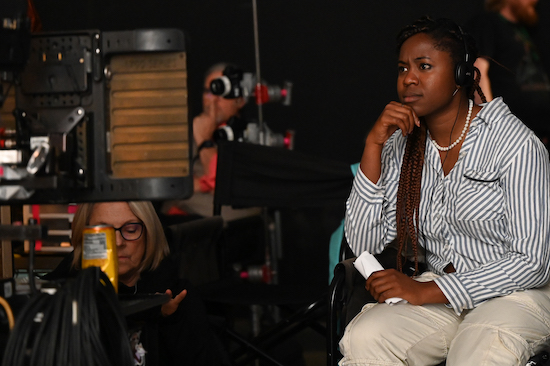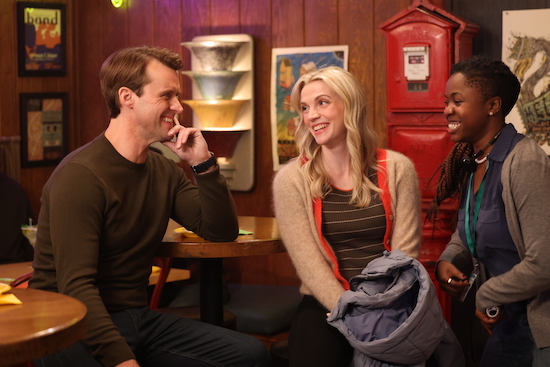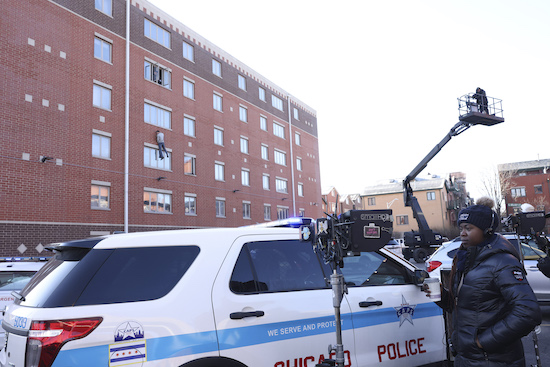CHICAGO FIRE Director Tayo Amos Breaks Down the Ambitious ‘Danger Is All Around’
April 13, 2023 by Marisa Roffman

Tayo Amos directing. Credit: NBCU
CHICAGO FIRE’s “Danger Is All Around” was a big episode for the series—with big emotional beats for multiple characters, on top of several jaw-dropping sequences—but it was also a momentous occasion for director Tayo Amos: it was her broadcast television debut.
Amos, who has directed a number of shorts, including MAGNOLIA BLOOM and ON THE CLOCK, was a participant in NBC’s Female Forward program. (Female Forward was the first directing mentorship program to guarantee its participants an episode of television upon completion. Alumni have directed episodes of AMERICAN AUTO, CHICAGO P.D., LAW & ORDER, LAW & ORDER: SVU, and more.)
Here, she talks with Give Me My Remote about stepping behind the camera for “Danger Is All Around”…
How did your journey take you to CHICAGO FIRE?
I was fortunate to get this through NBC’s Female Forward program, which is designed to shepherd more women directors into TV directing. So I had the opportunity to shadow two episodes on the show, episode 9 and 16, before directing episode 18.
I didn’t fully know the CHICAGO shows before I applied, but then as I went through the whole process, I got the opportunity to talk more to the producing director, and watched more of the show. I just really, really loved how it came together and the characters, and so it was really exciting to get the opportunity to helm an episode.
When you’re shadowing, you can frequently see how the actors and crew work—but one of the key participants in your episode, Jesse Spencer, was actually not around in the episodes you were there for. What was it like navigating that, given he does know this show and world so well, but his approach could be new to you?
Yeah, I was a little nervous before meeting him, not gonna lie. But the moment he came on set, it was like we knew each other—we’re just friends working on something awesome together. He is such a lovely person. Great actor, really about his craft…I just felt like, “Okay, let’s do the best work that we can and have some fun while doing it.” So it was great.

CHICAGO FIRE — “Danger Is All Around” Episode 1118 — Pictured: (l-r) — (Photo by: George Burns Jr/NBC)
You did a gorgeous job framing both the reveal of him when Casey and Stella (Miranda Rae Mayo) reunite, and also then Casey and Brett’s (Kara Killmer) reunion. What was your process like in setting up those shots?
I knew the writers really wanted the return of Jesse to have that climactic feeling, and…it’s having that entrance into the briefing room, I really just wanted to capture that motion. I think there’s something great about camera motion [that can] make the audience literally lean in. And I think the DP, Will Eichler, 100 percent understood what I was going for and was able to execute that vision.
And then for Brett and [Casey,] when they first see each other I was very inspired by…when they first got together, they had their first kiss and it was a Steadicam oner wrapping around them. And so I wanted the Steadicam [to] be in the language of them seeing each other again. So you’ll see when Brett enters, it’s kind of like a Steadicam movement, and then it becomes this kind of wrapped-around shot, a little bit, mimicking that first kiss moment.
Was that something you got inspiration from via your research or was that homage something that was always intended?
Fortunately, before I started prep for that episode, I had seen pretty much every episode of specifically Brett and Casey’s journey. And that episode, specifically, was a climax. And so I made sure to watch it. And I was fortunate enough to talk to the director [Lisa Robinson about] that episode. And I think hearing her feedback from the showrunners for what they were going for, to build up to that climax moment, was helpful for me as I was coming into this. And then also having conversations with writers, as well ahead of shooting this episode was helpful, too.
CHICAGO FIRE is no stranger to crazy calls the squad has to go on, but you had several difficult sequences to navigate. What can you share about the process of preparing those scenes and giving them the right scope?
Yeah, well, I gotta give a huge kudos to the producing team. They knew the bee scene was coming, so they had conversations already before I officially started prep, just to make sure we had what we needed to execute that scene. By the time I started prep, the special effects team pretty much had a plan. The visual effects team pretty much had a plan. And so it was a matter of figuring out the location and how to shoot it practically.
Thankfully, our locations team worked really hard on finding a house, so we had the exterior and the art department did a great job matching what we saw. So it was really up to me to just pick one. And then really all the departments just went above and beyond.
Then I made sure to storyboard both scenes, just to make sure that we have what we needed. And I had the storyboards next to me, and I would literally cross off when we got the shot just to make sure everyone was on the same page as to what we needed. I think that was really helpful. But, I mean, this show is incredible. In terms of the crew, every department was batting at 1000 for this one.
Something's buzzing on the #ChicagoFire set! The bees were the most labor-intensive work @MakeupByPayne has done on the show. There were nearly 2000 of them, all hand-painted with hand- glued wings. Take a look #behindthescenes here! 🐝 pic.twitter.com/6N1osNu4FI
— Wolf Entertainment (@WolfEnt) April 6, 2023
What was your process for shooting the scenes under the house?
Shout out to the art department! So, we had the house exterior, and then they built the crawlspace on our burn stage, where the show films pretty much every stunt scene, fire, anything.
So they built the stage, and then they have walls that would be removed and added so that our camera team could film accordingly. And we shot on pretty long lenses, so that they could follow Stella as she came in, and the husband, who was stuck in the PVC pipe, in both directions.
And I think what also helped was the fact that it wasn’t a crawlspace, it’s less light—we were able to get away with a lot more, in terms of what you’re seeing, and making sure the bees look believable.
And the bees were literally all fake; the bees on his shirt were molded individually, painted by hand by our head of special effects makeup Chris Payne, who painted the wings on. It was remarkable. I was stunned when we saw the bee suit. And then the additional bees in the air and on his face were added in post by the VFX team. So…I just felt like the traffic controller. I just kind of like, okay, this is where we’re putting things. But every department was hands-on, ready to make it happen.

Credit: NBCU
On the flip side, there was also the stunt where someone was hanging from the outside of a building. How did you approach that scene?
Yeah, I think it really helped to shadow two episodes, because there was one episode, specifically episode 9, where a motorcyclist was stuck on an elevated bridge. And that scene was stunts. And Reza [Tabrizi], the producing director, directed that episode. He did such an amazing job, of course. And I think it was really great to see his process of specifically aerial stunt work and how do you use the camera and the visual angle and the tools that you have to get the shots that you need?
At first, I thought I needed both a drone and a techno crane. But it turns out I just needed a techno crane. The benefit of using such an awesome piece of equipment is that you’re able to get very high shots—what really communicates suspense for scenes like that is having the depth and being able to have the camera above a person, so you see the people below smaller…[you] feel that sense of scale.
What was really great about the location that we picked was that you could see the train right behind them. And I don’t know if you can see it, but like there’s moments where Gallo’s holding Joel, the robber, and the train is beautifully just kind of crossing them in the background. And I was like, man, you can’t plan that better.
You had to balance a number of emotional storylines with the stunts and the lighter runner of trying to keep this shift streak alive. What was your approach to making them all seamlessly fit together?
I think it is just leaning into playing. These actors have been with these characters for so long, and they bring an element of understanding that I would love to see. [It’s] just seeing what they have, where their point of view is, and then shaping the performance from there.
For instance, in the Gallo scene in the storage unit, I just really had Alberto [Rosende] feel it out, and find those moments for himself. And then I would give him notes as to where I felt we could lean in more, explore more, try things more. But what I love about acting and talking to actors is just, yeah, explore—there’s no right answer. Just play.
And I always give actors a take to do whatever they want. Like, it can be completely wrong! But it’s that idea of leaning into play. That feels a little antithetical to say for something as serious as, you know, losing a family or losing the love of your life, but “play” meaning exploring and just seeing what comes once we put the scene on its feet.
Looking at the finished product, was there a moment or scene you had to cut that stands out?
Yeah. There was a moment—and I understand why it was cut—but at the top of the conference scene, I had crafted this kind of really nice opening shot. And there’s a side conversation between Casey and Kidd before he goes on stage that I thought was a really nice [nod] to their relationship. And it’s unfortunate that it was cut out, but it still plays. But that’s one scene that was like, “Darn it.” Because, you know, I really built that scene around that kind of side interaction, but there was no time. So it’s okay.
Was there a particularly difficult scene? Or your favorite?
I think I was most overwhelmed by the Molly’s scene at the end. I was so nervous, because it was so many [people]…everyone’s there. And it’s like, okay, how do we make it feel vibrant, and still catch all the character beats? Because that’s where we see Brett and Tony and Violet and Herrmann and Cindy. It’s a lot of emotional beats, with a lot of movement. Just having the Steadicam oner was really a great way of doing that, combined with some coverage.
Then the thing I’m most proud of, ironically—it seems like the most simple scene, but it’s the scene where Gallo sees his aunt for the first time…It’s this idea of that scene could have just been very simple: two people on a sidewalk and he just walks away. But this idea of finding this location and seeing there was an intersection. I was like, “Oh, what if we have Lacey across the street and this car coming by and there’s this car wipe? Yeah, that’s way better.” So I’m ironically most proud of that scene. I know it’s not the biggest scene or the coolest scene, the most emotional scene, but I think that’s the scene where I feel like, okay, I did my job as a director. Where I took a scene that was pretty strong on the page, but made it more elevated and cinematic.
That absolutely makes sense. Is there anything else you’d like to share about your experience?
I’m just really grateful to be a part of the show. The crew and the cast and the writers—everyone just worked so, so hard. And I think people, especially people who aren’t familiar with filmmaking, don’t realize the amount of hours it takes to make one hour of television. So I was really humbled to have been a shepherd of so many people’s talents and energies and time. I’m really grateful for the experience. And I hope people liked it!
CHICAGO FIRE, Wednesdays, 9/8c, NBC
RELATED:
- NBC Renews LAW & ORDER, SVU, ORGANIZED CRIME, and ONE CHICAGO Trio
- CHICAGO FIRE: ‘Danger Is All Around’ Photos
- CHICAGO FIRE: ‘The First Symptom’ Photos
- CHICAGO FIRE: ‘Acting Up’ Photos
- CHICAGO FIRE: Jesse Spencer to Return for Season 11 Episode
- How Did CHICAGO FIRE Write Out Taylor Kinney’s Severide?
- CHICAGO FIRE: ‘Damage Control’ Photos
- CHICAGO FIRE: ‘Run Like Hell’ Photos
- CHICAGO FIRE: ‘The Man of the Moment’ Photos
- Taylor Kinney is Taking a Hiatus From CHICAGO FIRE
- CHICAGO FIRE: ‘A Guy I Used to Know’ Photos
- CHICAGO FIRE: ‘Something For the Pain’ Photos
- CHICAGO FIRE’s Derek Haas and Andrea Newman on Utilizing CHICAGO P.D.’s Amy Morton for Lighter Moments
- CHICAGO FIRE Post-Mortem: Derek Haas and Andrea Newman on the Explosive Cliffhanger
- CHICAGO FIRE: ‘A Beautiful Life’ Photos
- Derek Haas to Exit CHICAGO FIRE and FBI: INTERNATIONAL
- CHICAGO FIRE: ‘Angry is Easier’ Photos
- CHICAGO FIRE: ‘All-Out Mystery’ Photos
- CHICAGO FIRE’s Jimmy Nicholas Reflects on His On-Screen Partnership with Hanako Greensmith
- CHICAGO FIRE: Hanako Greensmith, Daniel Kyri, and Alberto Rosende Preview ‘Haunted House’
- CHICAGO FIRE: ‘Haunted House’ Photos
- CHICAGO FIRE: Jimmy Nicholas on Filming the ‘Loaded’ ‘Completely Shattered’ and ‘Pure Love’ From Fans
- CHICAGO FIRE: Jimmy Nicholas Reveals a Sweet Hawkami Milestone was Unscripted
- CHICAGO FIRE: ‘The Center of the Universe’ Photos
- CHICAGO FIRE: Hanako Greensmith on the ‘Completely Shattered’ Fallout: Violet is Experiencing ‘Some of the Hardest Grief a Person Can Go Through’
- The CHICAGO FIRE EPs, Alberto Rosende on How Carver is Shaking Things Up
- CHICAGO FIRE: Derek Haas and Andrea Newman Preview Javi Visiting the Firehouse, Gallo’s New Romantic Interest
- CHICAGO FIRE: ‘Completely Shattered’ Photos
- CHICAGO FIRE Post-Mortem: Derek Haas, Andrea Newman, and Hanako Greensmith on the Relationship Shifts
- CHICAGO FIRE: What You Need to Know About the Season Premiere
- CHICAGO FIRE Bosses Tease Stellaride in ‘A Lot of Danger’ and the New Addition Shaking Up Firehouse 51
- CHICAGO FIRE: ‘Every Scar Tells a Story’ Photos
- CHICAGO FIRE Season 11 Premiere: ‘Hold on Tight’ Photos
- ONE CHICAGO: NBC Reveals New Posters for CHICAGO MED, CHICAGO FIRE, and CHICAGO P.D.
- CHICAGO FIRE Recap: Did Stellaride Tie the Knot?
- CHICAGO FIRE: ‘The Magnificent City of Chicago’ Photos
- CHICAGO FIRE: Derek Haas and Andrea Newman Preview Stellaride’s Wedding, Casey and Brett’s Return, and More
- CHICAGO FIRE: ‘Last Chance’ Photos
- CHICAGO FIRE: Derek Haas and Andrea Newman Preview the Next Step in Violet and Emma’s Feud, an ‘Extremely Dangerous’ Storyline for Severide, and More
- CHICAGO FIRE: ‘Halfway To The Moon’ Photos
- CHICAGO FIRE: Jesse Spencer to Return for Season 10 Finale
- CHICAGO FIRE: ‘Finish What You Started’ Photos
- CHICAGO FIRE: Derek Haas and Eamonn Walker Preview Boden Being Taken Hostage
- CHICAGO FIRE: ‘What’s Inside You’ Photos
- CHICAGO FIRE Post-Mortem: Hanako Greensmith and Andrea Newman on the ‘Rejiggering’ to Hawkami
- The CHICAGO FIRE Team Teases a Possible Stellaride Wedding
- CHICAGO FIRE: ‘Keep You Safe’ Photos
- CHICAGO FIRE: Hanako Greensmith Previews Violet’s Romantic Drama—and the Reveal of a Secret Skill
- CHICAGO FIRE Post-Mortem: Director Kantú Lentz Breaks Down ‘Fire Cop’
- CHICAGO FIRE Post-Mortem: Derek Haas on Kidd’s Return and What it Means for Firehouse 51
- CHICAGO FIRE: Derek Haas Teases Kidd’s Return, Brett’s Big Presentation, and Christmas Cheer Going Awry
- NBC Boss Teases Potential LAW & ORDER and ONE CHICAGO Crossovers
- CHICAGO FIRE Post-Mortem: Derek Haas Breaks Down the Wildly Ambitious ‘My Lucky Day’
- Daily Dose of Joy: ONE CHICAGO Stars Play Trivia for Charity
- NBC Renews ONE CHICAGO Trio for 3 Seasons
- CHICAGO FIRE Boss on Highlighting Firefighter Cancer Support Network
- Dick Wolf on What He’s Learned About Expanding Television Franchises
- ONE CHICAGO Stars on the Cut Crossover Ending
- CHICAGO FIRE’s David Eigenberg & Christian Stolte Crash Eamonn Walker & Jesse Spencer’s Interview
- CHICAGO FIRE: Taylor Kinney and Miranda Rae Mayo on Severide and Stella’s Relationship
Follow @GiveMeMyRemote and @marisaroffman on Twitter for the latest TV news. Connect with other TV fans on GIVE ME MY REMOTE’s official Facebook page.
And be the first to see our exclusive videos by subscribing to our YouTube channel.
As an Amazon Associate we earn from qualifying purchases made through links/ads placed on the site.
Related Posts
Filed under Chicago Fire
Comments Off on CHICAGO FIRE Director Tayo Amos Breaks Down the Ambitious ‘Danger Is All Around’



Comments